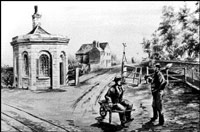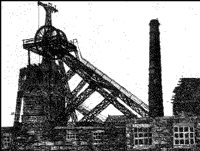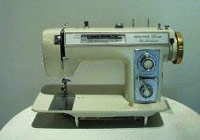 Township Information - Audenshaw
Township Information - Audenshaw
Early History
The origin of the name is probably from the personal name 'Aldwine' meaning Aldwine's shaw or copse, and earliest records of the name are 12th century and 13th century.
Up to 1874 Audenshaw was one of the four divisions of Ashton Parish, consisting of the hamlets of Woodhouses, Waterhouses, Littlemoss, Audenshaw, Medlock Vale and Hooley Hill. In 1874 it established its own local board and in 1894 became an Urban District. Early 19th century Audenshaw appeared to have been a pleasant rural area. In 1823 John Butterworth described the Audenshaw hamlet as 'several rows of humble cottages'. Hooley was a populous village of 1,500 people and the hamlet of Waterhouses was described as 'a beautiful hamlet, the greatest part of which lies at the bottom of a deep glen'.
The population of Audenshaw in 1801 was 2,000 and by 1901, it was 7,000. There was a rapid increase between 1931 and 1951 - 8,461 to 12,600 people. By 1991 it had risen only slightly to 13,170.
In the Thirties and Fifties there were extensive programmes of house building and developments in engineering and other light industries.
Turnpikes
 In 1732 an Act of Parliament was passed, allowing the turnpike road from Manchester to Mottram to be constructed. The company contracted to do the work was the Manchester to Saltersbrook Turnpike Trust. They mainly improved the existing road and set up a toll bar in Audenshaw village. In 1824 the new bypass section began which ran across the eastern end of Ashton Moss. The toll bars were used to control crowds threatening to riot during the Plug Riots of 1842. The tolls at Snipe Tavern and Old Audenshaw were manned by 'one gentleman and twelve special constables'.
In 1732 an Act of Parliament was passed, allowing the turnpike road from Manchester to Mottram to be constructed. The company contracted to do the work was the Manchester to Saltersbrook Turnpike Trust. They mainly improved the existing road and set up a toll bar in Audenshaw village. In 1824 the new bypass section began which ran across the eastern end of Ashton Moss. The toll bars were used to control crowds threatening to riot during the Plug Riots of 1842. The tolls at Snipe Tavern and Old Audenshaw were manned by 'one gentleman and twelve special constables'.
Turnpikes declined in the latter part of the 19th century due to competition from canals and railways but the Manchester to Saltersbrook Turnpike Trust appeared to be still in existence in 1884.
Many of the old buildings of Audenshaw were drowned during the construction of three reservoirs from 1877-1882. They were constructed by Manchester Corporation and covered 283 acres. Other old buildings of interest such as Dean Head Farm, built in 1671-2, have since been demolished.
Red Hall and the Red Hall Methodist Chapel were among those buildings drowned by the reservoirs. Red Hall was built in 1672. The estate, which included a large part of the hamlet of Audenshaw, had been given to Captain Ralph Stopford, a captain in Cromwell's army, by Cromwell himself. The Hall passed into the Hobson family. Edward Hobson started a day school in 1740 and, until recently, his charities were used for educational purposes. After his death in 1764, Red Hall passed into the possession of Robert Thornley who built a small factory on the side for furriers and skin dressers. The Thornley brothers were strongly interested in the Methodist revival, and were involved in the building of Red Hall Chapel which was opened on April 21, 1783, near the Hall. It was part of the Stockport Weslyan Circuit, and on April 6, 1786, John Wesley took services at Red Hall when he was 83.
On Audenshaw Road are Priory Cottages - three cottages built in 1793. It is not known for whom the premises were originally built, but it is believed that about 100 years ago they were used as a farmhouse. They were bought during the First World War by Robert Noblett who owned a tanning and leather dressing factory on Audenshaw Road (closed in 1965) for some of his employees. He renovated the cottages, providing toilets, but the original oak beams remained. In the early 1960s they were taken over by Audenshaw Council.
Industrialisation
 Until the 19th century, Audenshaw was mainly a farming area supplemented by bleaching, hatting and coal mining which continued well into the 20th century. At Hooley Hill, farming gave way to calico printing works during the 19th century, and later a linen factory was established. There was some hatting in Hooley Hill. Butterworth, a local historian, mentions two working hatters in 1823, but during the 19th century the area became a slum and was to be demolished to be rebuilt later.
Until the 19th century, Audenshaw was mainly a farming area supplemented by bleaching, hatting and coal mining which continued well into the 20th century. At Hooley Hill, farming gave way to calico printing works during the 19th century, and later a linen factory was established. There was some hatting in Hooley Hill. Butterworth, a local historian, mentions two working hatters in 1823, but during the 19th century the area became a slum and was to be demolished to be rebuilt later.
Coal mining started in the 18th century, working valuable seams near the surface, and, as these became waterlogged or exhausted, 19th century mining changed to deep seam mining. The Chamber Colliery Mining Company owned three pits; Oak Pit in Oldham, Wood Park Pit in Bardsley and the Ashton Moss Pit, Audenshaw, known as the Snipe Pit. All three worked the famous Roger Seam. The Ashton Moss Colliery opened on May 22, 1880 and tram lines were laid to take coal down to the canal locks. The Chamber Colliery Company had a large number of canal boats in the 1920s to take coal from the Snipe Pit to factories along the canal. The Snipe Pit was one of the deepest at the time. According to the Colliery Guardian in 1892, the shafts went down 952 yards and produced good quality coal. Saltpetre was adapted for gas, domestic use or steam power and coal from the Black Mine seam was well-known locally for producing good gas and domestic coal. The colliery closed in 1959.
James Robertson
James Robertson started factory production in 1864 in Paisley of his Golden Shred marmalade, and built the Manchester factory in 1890 in Audenshaw on the banks of the Ashton Canal. In 1900 the London factory at Catford was built, followed by Bristol in 1914. By 1954 the four factories were employing over 3000 people.
Jones Sewing Machines
 Jones Sewing Machines was founded at Guide Bridge by two brothers, William and John Jones in 1859. William Jones was originally the owner of an engineering firm specialising in very small steam engines for domestic use. After the invention of the sewing machine in the 1840s, he was able to develop special tools to promote large scale production of domestic and industrial machines supplied to clothing manufacturers such as Burtons. The business expanded and in 1889 became a limited liability company. The firm was affected by the Second World War but recovered later in the 20th century. The single story factory stands opposite the original factory completed in 1870.
Jones Sewing Machines was founded at Guide Bridge by two brothers, William and John Jones in 1859. William Jones was originally the owner of an engineering firm specialising in very small steam engines for domestic use. After the invention of the sewing machine in the 1840s, he was able to develop special tools to promote large scale production of domestic and industrial machines supplied to clothing manufacturers such as Burtons. The business expanded and in 1889 became a limited liability company. The firm was affected by the Second World War but recovered later in the 20th century. The single story factory stands opposite the original factory completed in 1870.
The Twentieth Century
By the 1930s engineering and market gardening on Ashton Moss and a variety of light industries were being developed, particularly on the Shepley Industrial Estate. This was originally the site of Shepley Hall which was given by Jane, daughter of Peter de Shepley, to Geoffrey, son of Sir Thomas de Assheton, as a dowry during the reign of Henry VI in the 15th century. The industrial estate which became known as 'Little Trafford Park' was developed after the Second World War by Nathan Brown, who was in light engineering. Audenshaw industrialists moved out of confined city areas to more spacious sites where access to Manchester and other city centres was easily available.

